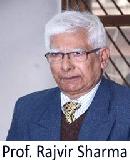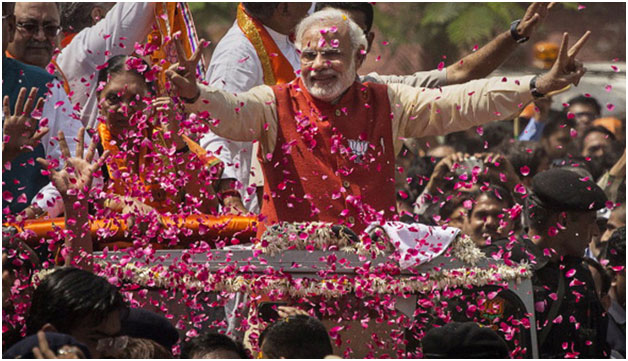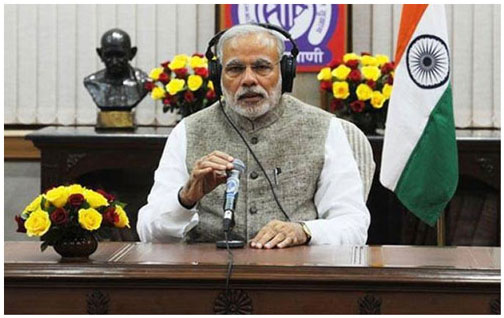 There was euphoria all around in the country when elections to the Lok Sabha were being held in 2014. The Youth, the women, the industry, commerce, business and trade, the labour, the employer, name any one and s/he was in the frenzy mode of change. For them it was not merely an occasion to replace one political party or a combination of parties with another political party in the seat of authority, they all were dreaming something beyond that.
There was euphoria all around in the country when elections to the Lok Sabha were being held in 2014. The Youth, the women, the industry, commerce, business and trade, the labour, the employer, name any one and s/he was in the frenzy mode of change. For them it was not merely an occasion to replace one political party or a combination of parties with another political party in the seat of authority, they all were dreaming something beyond that.
They rendered whole hearted support to a political leader who was full of confidence, vigour, determination and energy to transform not only the lingua franca of electoral politics beyond parochial boundaries of caste, class, region or religion, but also the agenda that saw nothing but the urges and aspirations of a new India. The electorate exhibited huge trust in Mr Modi when he promised a corruption free, hunger free, fear free India.
He asserted that these demons were eating into the vitals of Indian democracy and were responsible for pushing back India every time it ventured into the territory of progress, equality, justice and freedom. Differently stated, discrimination, exploitation and deprivation of a large mass of people continued to be the important features of India at 70. This environment gripped the country with hopelessness, helplessness, demoralization and a sort of depression.
The society accepted poverty, inequality and dishonesty as given or as a fait accompli. At this point of time a new wave of change was being made by the BJP under the leadership of Narendra Modi. He reenergized the nation and assured it that he would give to her a government with a difference based on the new approach and strategy of ushering in a transformational politics and transformational governance. Elections to the Lok Sabha were won by the BJP with a majority of its own in 2014. This happened in India after a long coalition era of about three decades.
The recapitulation of the history was done to put the discussion in a perspective and also to examine the developments in politics and governance thereafter.

The present NDA government under the strong leadership of Mr Modi faced the first challenge of putting an end to black economy and brings back the black money stashed abroad. The opposition began to question as to where are 15 lakh rupees to each persons’ account. Though it is true that this promise was as notional in nature as the national debt per capita is. It is also true that the government through administrative, legal and financial reforms is meant to realize the goals it set for itself. It would not be my endeavour to recall and place all the required steps taken into the body of this presentation, yet it would be pertinent to quote two very significant measures of reform- risky and bold- to make our economy corruption free, honest and transparent in its transactions.
There could be many more motives behind these initiatives, but the most credible was the fight against black parallel economy. Demonetization (Note Bandi) and Goods and Services tax were conscious and deliberate risky decisions taken by the Modi Government drawing vehement opposition from the Non-NDA political Parivar and their ally intellectuals as well. The government, however, rejected the opposition by saying that it has the mandate of the people in general and of the poor specifically for these reforms as was evident from the resounding victory of the BJP in state after state in their aftermath.

There is however a continuous effort by the opposition to criticize the government on the so called utter failure of the decisions, especially on account of slowing down of the economy and fall in the employment generation. The BJP on the other hand is accusing the opposition of regenerating an environment of despondency in the country again and for pushing the youth, and the people into the darkness of frustration and hopelessness of the yester years, trying to shatter the minds and the hearts of the rejuvenated vibrant India.
The initiatives at digitalization of transactions, enactment of laws governing Benami properties and Insolvency are being cited as efforts at arresting the menace of corruption in the country by the party in power. The long term economic and legal reforms put in place in the last three years have enabled India to improve its ranking from 142 to 100 in the area of ease of doing business, though questioned by the congress.
Again the foreign policy and security policy reorientations have also been appreciated by the people at large. The surgical strike in POK, Myanmar and firm response to China in Doklam along with her success in isolating Pakistan and China on the issue of terrorism can be taken as the matter of national pride. The role which India played at the BRICS summit held in China recently in 2017, the focus on modernization of our police and defense establishment is being claimed rightly as additional achievements of this government.
However, it is equally true that some of the harsh and hard measures are meant to dislocate and dissuade some parts and elements of the economy and the society from its traditional paths as they are aiming to closing the doors to the practices, procedures and modes of doing business in vogue in the past. This government is on the path of differentiated welfare of the social strata. Those who are capable to pay for the goods and services they consume should pay seem to be the guiding principle of subsidies.
The main goal is to keep the inflation, the fiscal and revenue deficit at low levels. To some extent, the government is withdrawing from the politics of appeasement, of populism driven by politics of distribution of freebies to follow the politics of reform, perform and transform to borrow the words of the Prime Minister. This changed approach to governance is causing unease not only among the powerful political and manufacturing/big business lobbies but also the upper middle and middle class.
A struggle has ensued in the post 2014 Lok Sabha elections between the forces of status quo and the leaders of change. Let us see who wins?
(The writer is senior consultant with IGNOU)
